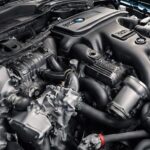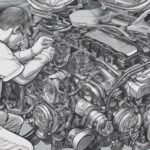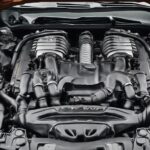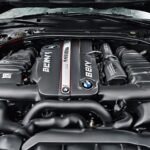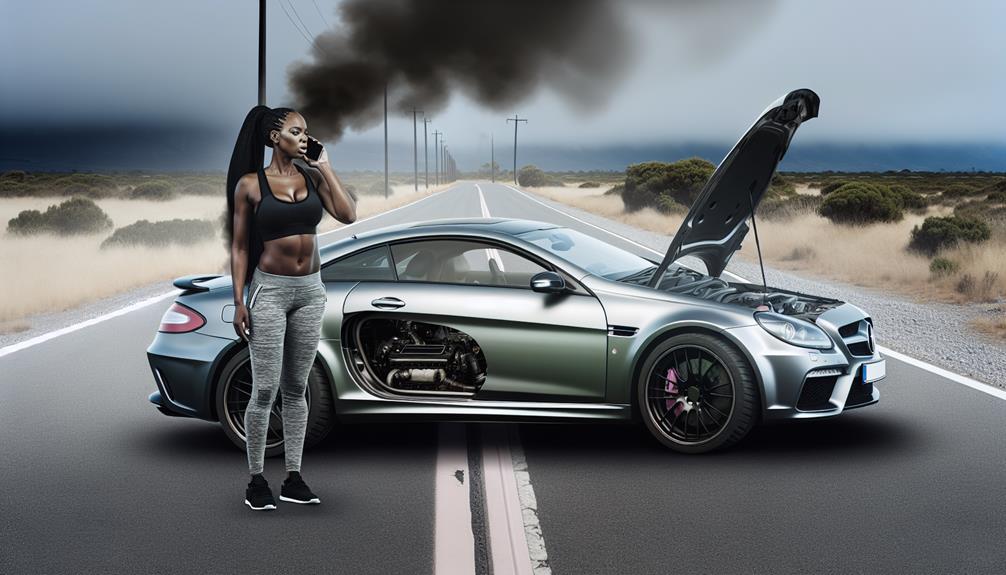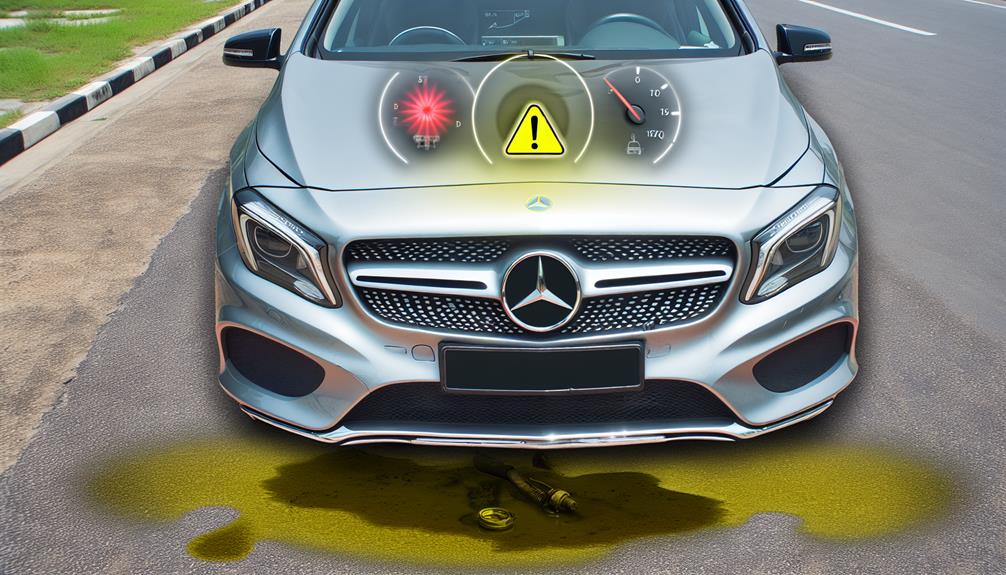If you own a Mercedes 190E (W201), be sure to watch out for engine overheating due to water pump or thermostat issues, address transmission slipping caused by worn clutch plates or low fluid levels, and deal with electrical system problems promptly. Keep in mind spongy brakes affecting performance, steering and suspension challenges like worn tie rod ends, and cooling system maintenance to prevent coolant leaks or radiator problems. Regularly check for fuel system troubles, HVAC malfunctions, and exhaust system concerns to maintain your car running smoothly. Understanding these common issues guarantees you can preserve your vehicle's condition and performance effectively.
Key Takeaways
- Watch for engine overheating due to water pump or thermostat issues.
- Address transmission slipping with fluid level checks and filter replacements.
- Troubleshoot electrical system faults promptly to prevent battery drain.
- Monitor brake system for spongy brakes, noise, and fluid leaks.
- Maintain steering and suspension components to avoid performance issues.
Engine Overheating

Wondering why your Mercedes 190E is prone to engine overheating? One common culprit could be a water pump failure, leading to coolant circulation issues. When the water pump malfunctions, it fails to circulate coolant effectively through the engine, resulting in inadequate heat dissipation and ultimately causing the engine to overheat.
Additionally, a malfunctioning thermostat can disrupt the engine's cooling system by either not allowing coolant to flow properly or by causing it to flow constantly, both of which can lead to overheating issues in your 190E.
To prevent these problems, regular maintenance of the cooling system is essential. This includes checking for any leaks, ensuring proper coolant levels, and conducting timely coolant flushes. By maintaining your cooling system, you can help prevent water pump failures, thermostat malfunctions, and coolant circulation issues that may contribute to engine overheating in your Mercedes 190E.
Transmission Slipping
If you observe your Mercedes 190E (W201) experiencing transmission slipping, it could be due to worn clutch plates or low transmission fluid levels. Symptoms such as delayed shifting, RPM spikes, and a burning smell often accompany this issue.
Promptly addressing transmission slipping is vital to prevent further damage and maintain peak performance of your vehicle.
Causes of Slipping
When experiencing slipping issues in your Mercedes 190E (W201), it's important to address potential causes such as low transmission fluid levels, worn-out transmission bands and clutches, or faulty transmission solenoids.
Low transmission fluid can lead to inadequate lubrication and overheating, causing slipping. Worn-out components like transmission bands and clutches may not engage properly, resulting in slipping between gear shifts. Faulty transmission solenoids can disrupt the smooth operation of the transmission, leading to slipping problems.
Transmission Repair Options
To effectively address transmission slipping in your Mercedes 190E (W201), consider exploring various repair options available to restore peak function. Begin by adjusting the transmission fluid level, replacing the transmission filter, and performing a transmission flush to potentially resolve the slipping issue.
If these initial steps don't rectify the problem, more extensive measures such as a transmission rebuild or replacement might be necessary for best performance. It's advisable to seek the expertise of a qualified mechanic or transmission specialist for a precise diagnosis and appropriate course of action.
Electrical System Faults
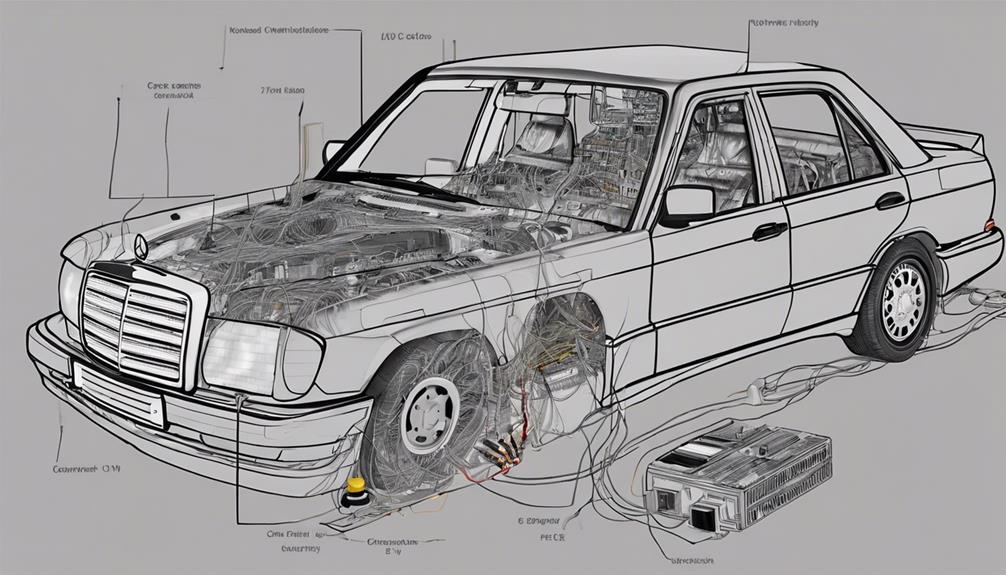
When dealing with electrical system faults in your Mercedes 190E (W201), it's vital to address potential wiring issues promptly.
Troubleshooting battery drain and inspecting fuse box connections can help identify and resolve common electrical problems in your vehicle efficiently.
Wiring Issues Diagnosis
Properly diagnosing wiring issues in the Mercedes 190E is crucial for addressing electrical system faults effectively. When dealing with wiring problems, follow these steps for accurate diagnosis:
- Check for Continuity: Verify there are no breaks in the wiring that could interrupt the flow of electricity.
- Look for Shorts: Identify any areas where the wiring may be touching or exposed, causing a short circuit.
- Test Voltage Levels: Confirm that the voltage throughout the electrical system is within the correct range to prevent malfunctions.
Battery Drain Troubleshooting
When troubleshooting battery drain in your Mercedes 190E (W201), start by pinpointing the source of the electrical drain using a multimeter. Common causes of battery drain in the 190E include faulty alternator diodes that draw power when the engine is off and parasitic draws from components like interior lights, radio, or the alarm system.
To identify the issue, test the battery drain with a multimeter to isolate the source accurately. Look out for defective door switches, trunk lights, or aftermarket accessories as potential culprits.
Regularly checking and maintaining your Mercedes 190E's electrical system can help prevent battery drain problems and ensure a reliable performance on the road.
Fuse Box Problems
To address fuse box problems in your Mercedes 190E (W201), it's essential to understand their potential impact on the electrical system's functionality and overall vehicle performance.
- Blown Fuses: Blown fuses are a common issue within the fuse box, leading to the disruption of various electrical components.
- Corroded Connections: Corrosion in the connections can hinder the flow of electricity, causing malfunctions in the system.
- Melted Components: Overheating can result in melted components within the fuse box, ultimately affecting the electrical system's reliability.
Regular inspection and timely resolution of fuse box problems are critical to maintaining the integrity of the electrical system in your Mercedes 190E. Addressing these issues promptly can help prevent more significant electrical system faults and guarantee a smooth driving experience.
Brake System Issues
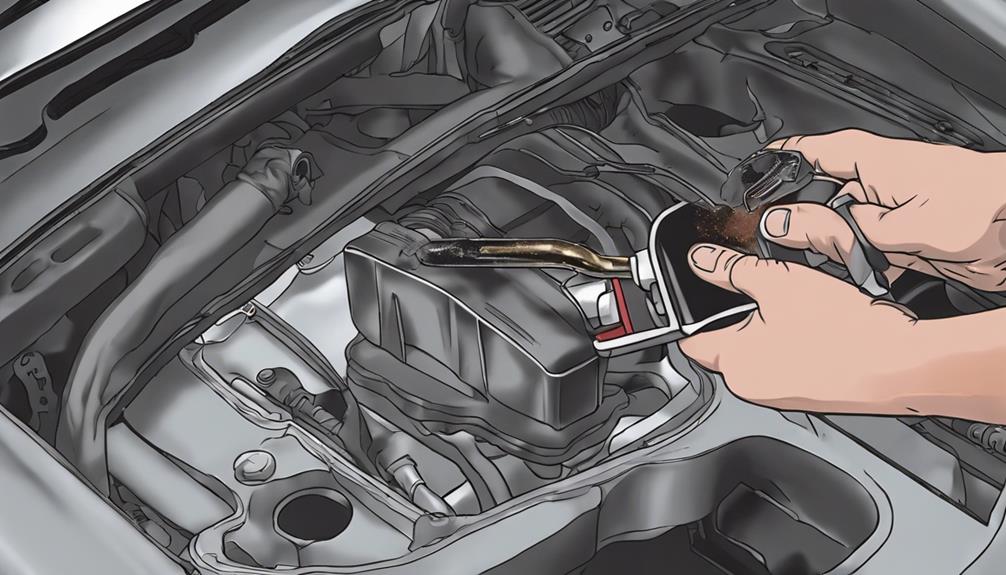
Brake issues in the Mercedes 190E often manifest as spongy brakes, impacting braking performance substantially. Spongy brakes can make it challenging to come to a quick stop, posing a safety risk. Additionally, brake noise can indicate worn brake pads or underlying issues with the brake system that necessitate immediate attention. Regularly monitoring brake pad wear is essential to prevent damage to the rotors and guarantee safe braking performance. If the ABS light illuminates on your dashboard, it may signal problems with the anti-lock braking system that require prompt diagnosis and repair. Addressing brake fluid leaks promptly is critical to maintaining proper brake function and ensuring your safety on the road.
| Brake System Issues | Description | Importance |
|---|---|---|
| Spongy Brakes | Decreased braking performance, difficult to stop quickly | Safety risk |
| Brake Noise | Indicates worn brake pads or system issues, needs immediate attention | Prevents rotor damage, guarantees safe braking |
| ABS Light | Signals problems with the anti-lock braking system, requires diagnosis and repair | Essential for safe braking |
Steering and Suspension Problems
Experiencing steering wheel vibration in your Mercedes 190E could result from worn tie rod ends, idler arm, or drag link components. Addressing these issues promptly is essential in maintaining your vehicle's performance. Here's what you need to know:
- Worn Tie Rod Ends: When the tie rod ends wear out, it can lead to imbalanced steering and contribute to steering wheel vibration. Regular inspection and timely replacement are important.
- Idler Arm Concerns: The idler arm plays a significant role in the steering mechanism. If it becomes worn or damaged, it can cause instability in the steering, resulting in vibrations felt through the wheel.
- Drag Link Components: Issues with drag link components can also contribute to steering problems. If these parts are worn or faulty, they can impact the alignment and overall handling of your Mercedes 190E.
Cooling System Challenges

If you notice coolant leaks, radiator issues, or water pump failures in your Mercedes 190E, you may be facing common cooling system challenges. Addressing these issues promptly is important to prevent potential engine damage and costly repairs in the future. Symptoms of cooling system problems, such as overheating or a rising temperature gauge, should not be ignored. Regular maintenance, including checking coolant levels and inspecting hoses for wear, plays a significant role in preventing these challenges. Following the manufacturer's guidelines for maintaining the cooling system and using the recommended coolant are essential practices to guarantee the longevity of your Mercedes 190E.
| Common Cooling System Challenges | Symptoms | Prevention and Maintenance |
|---|---|---|
| Coolant Leaks | Overheating, low coolant | Regularly check for leaks |
| Radiator Issues | Rising temperature gauge | Flush and replace coolant as needed |
| Water Pump Failures | Engine overheating | Inspect and replace as necessary |
Fuel System Troubles
When facing fuel system troubles in your Mercedes 190E, addressing issues promptly is essential to maintain excellent engine performance and safety. Several components within the fuel system can lead to problems if not properly maintained:
- Fuel Pump: A failing fuel pump can disrupt the flow of fuel to the engine, resulting in poor performance.
- Fuel Filters: Clogged fuel filters can hinder the delivery of fuel to the engine, causing operational issues.
- Fuel Leaks: Any leaks in the fuel lines or connections can't only lead to fuel odors inside the car but also pose a serious fire hazard.
Keeping a close eye on these important elements of your Mercedes 190E's fuel system can help you avoid major breakdowns and guarantee your vehicle runs smoothly. Regular inspections and timely replacements of components like fuel pumps, filters, and fuel lines can go a long way in maintaining the efficiency and safety of your car.
HVAC System Malfunctions
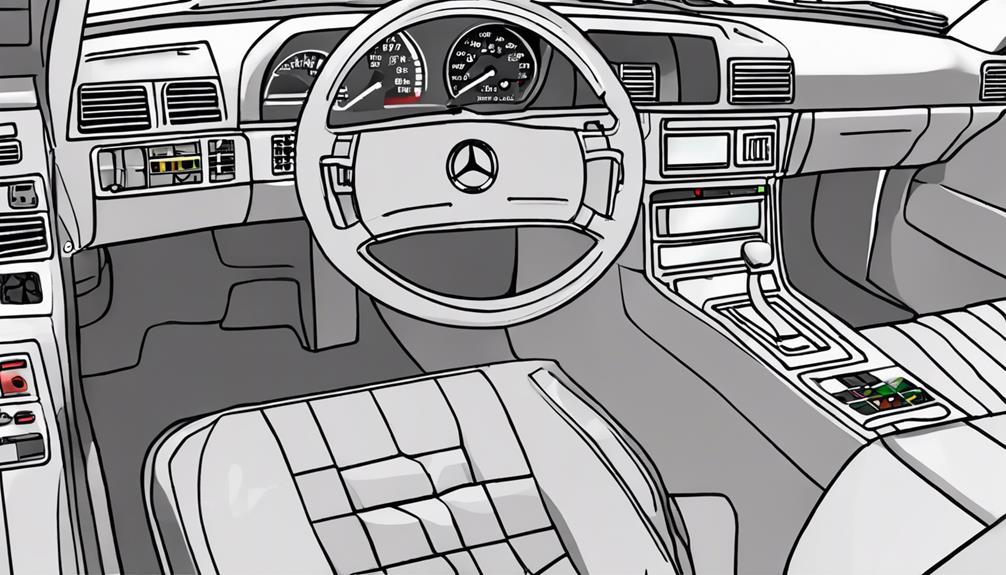
Facing HVAC system malfunctions in your Mercedes 190E (W201) can disrupt your driving comfort and impact essential climate control functions. Common issues include the heater not working correctly, leading to discomfort in colder weather.
Additionally, blower motor failures are known to affect the overall performance of the HVAC system, causing disruptions in airflow and temperature regulation. Defroster problems can also arise, compromising visibility and safety during adverse weather conditions.
These malfunctions can result in the A/C not cooling efficiently and inconsistent temperature control, making your driving experience less pleasant. It's important to address these HVAC system issues promptly to maintain a comfortable cabin environment and ensure peak functionality of your Mercedes 190E (W201).
If you encounter any of these problems, seeking professional assistance to diagnose and repair the root cause is recommended to restore your HVAC system to its proper working condition.
Exhaust System Concerns
Your Mercedes 190E (W201) might encounter exhaust system concerns, such as leaks, rattling noises, and corrosion, which can impact its overall performance and require prompt attention. When facing issues with your exhaust system, it's essential to address them promptly to prevent further damage. Here are some key points to keep in mind:
- Leaks: Exhaust leaks can occur at various points in the system, leading to decreased efficiency and potential safety hazards.
- Rattling Noises: Unusual rattling sounds from the exhaust could indicate loose components or internal damage that need immediate inspection.
- Corrosion: Over time, the exhaust system is prone to corrosion, especially in regions with harsh weather conditions, which can weaken the system's structure.
Regularly checking your Mercedes 190E's exhaust system for these common problems can help maintain its performance and ensure a safe driving experience. If you notice any signs of exhaust system issues, it's advisable to consult a professional mechanic for thorough diagnosis and repair.
Frequently Asked Questions
Is the Mercedes W201 Reliable?
Yes, the Mercedes W201 is reliable. Its reputation for durability and longevity is well-deserved. Routine maintenance and timely repairs are important for its reliability. With proper care, the solid build quality and robust engineering guarantee a dependable vehicle.
What Does W201 Mean?
W201 is the internal chassis code for the Mercedes 190E, the first generation of the E-Class lineup. It's a symbol used to identify and categorize this classic model within the Mercedes-Benz family.
How Rare Is 190E Mercedes?
The Mercedes 190E (W201) isn't rare with over 1.8 million units produced. Despite its commonality, enthusiasts and collectors cherish its durability and design. Well-kept, low-mileage 190Es can fetch high prices in the used car market.
How Fast Is the W201?
When driving a Mercedes 190E (W201), you can expect a top speed ranging from 118 mph to 135 mph, dependent on the model and engine setup. The acceleration times vary, with 0-60 mph achieved in 8.5 to 10.5 seconds across different versions.
Conclusion
Overall, the Mercedes 190E (W201) may experience common problems such as:
- Engine overheating
- Transmission slipping
- Electrical system faults
- Brake system issues
- Steering and suspension problems
- Cooling system challenges
- Fuel system troubles
- HVAC system malfunctions
- Exhaust system concerns
It's important to regularly maintain and address these issues to guarantee the longevity and performance of your vehicle. Stay proactive and address any potential problems before they escalate to costly repairs.

